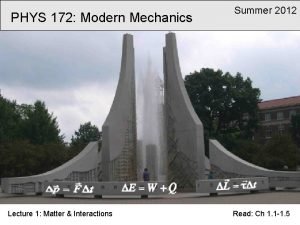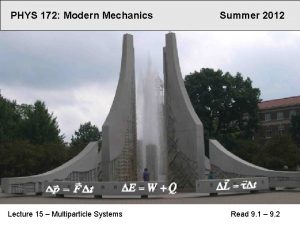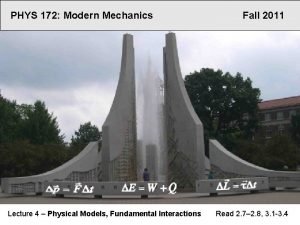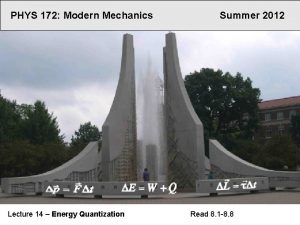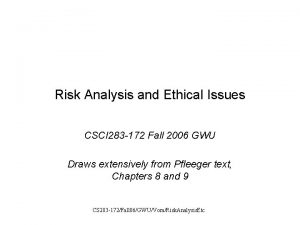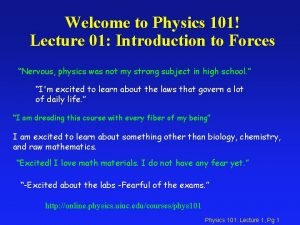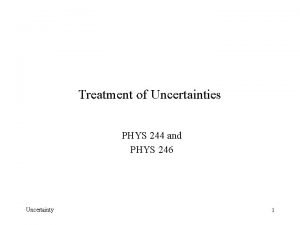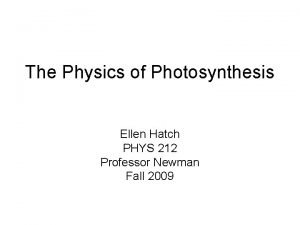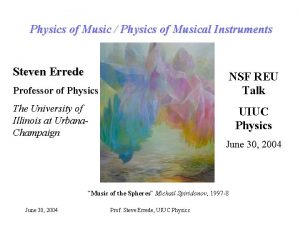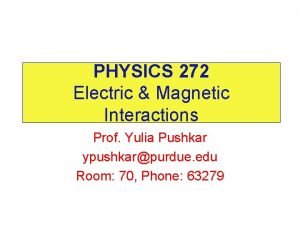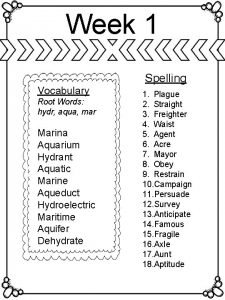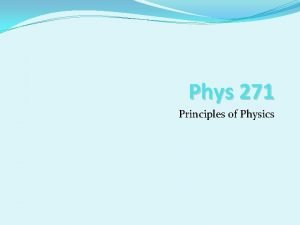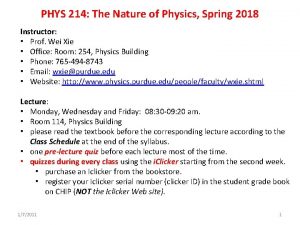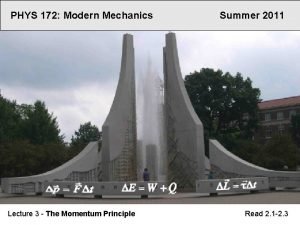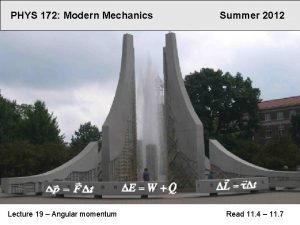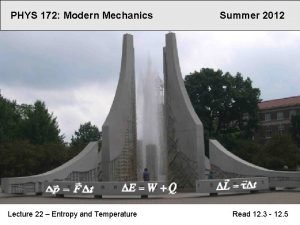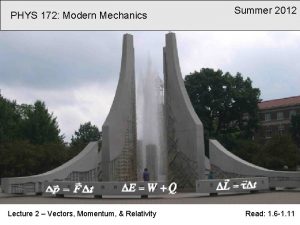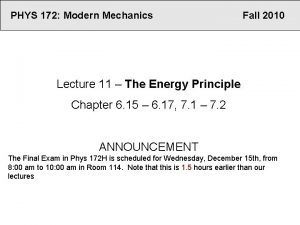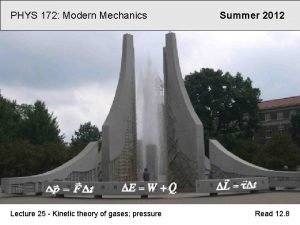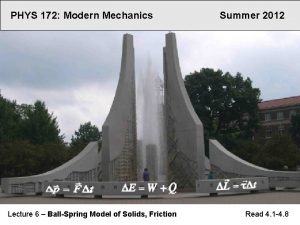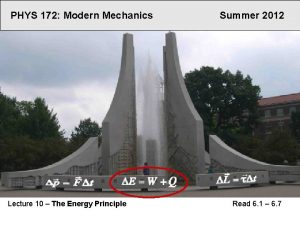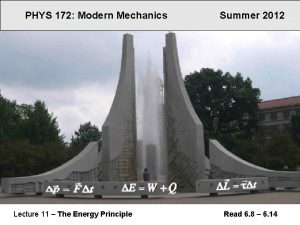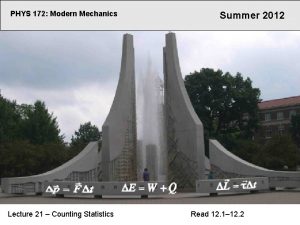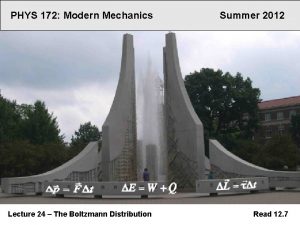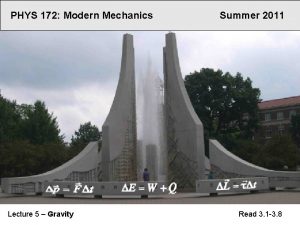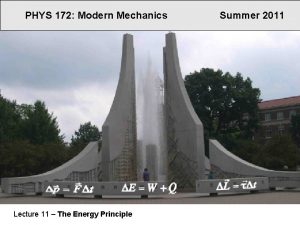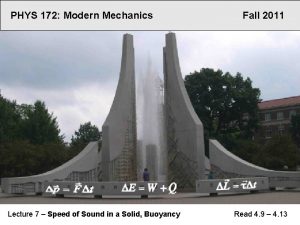PHYS 172 Modern Mechanics Lecture 1 Matter Interactions




























- Slides: 28

PHYS 172: Modern Mechanics Lecture 1: Matter & Interactions Summer 2012 Read: Ch 1. 1 -1. 5

To do AS SOON AS POSSIBLE: 1. Obtain the textbook (campus bookstores, used is OK, but you are responsible for material in the 3 rd Edition!). 2. Obtain the Lab Manual (from bookstore). 3. Obtain an i. Clicker audience response remote (not a CPS pad). 4. Register for Web. Assign, the on-line homework service. 5. Register your i. Clicker on CHIP, your on-line gradebook. 6. Click on the course URL for any late announcements, etc: www. physics. purdue. edu/academic_programs/courses/phys 172 (or poke around Physics home page, www. physics. purdue. edu)

Syllabus & General Information: This is a 4 credit hour course. The rule of thumb at this University is that you should spend twice as many hours (on average) studying for this course outside of class as you do in class. That is, eight sixteen(!) hours a week spent reading, doing the homework, recitation, and laboratory assignments, and studying for the quizzes and exams would be a typical investment of time for most students in this course.

For those of you who brought your i. Clicker with you today, let’s do a test run: Turn the Power on. After the question is declared “Open”, choose one: A. My last physics class was in high school. B. My last physics class was in college. C. I have never taken a physics class. D. I have never heard of Physics. E. None of the above. NOTE: From now on, always bring your i. Clicker to lecture with you. The clicker questions count towards your grade. i. Clicker questions may be asked any time during lecture: don’t be late!

During the first week you will: • Attend the four scheduled lectures, on M, T, W, Th. • Attend the Recitation session assigned to you by the Registrar. • Log in to Web. Assign and complete the appropriate HW. Note due dates for subsequent HWs. • Lab meetings will not be held Tuesday. Instead, log in to Web. Assign and complete “Lab #1 Orientation” by Wed, June 15. Attendance is required for three exams this semester: Exam 1: Exam 2: Final: Wed, June 27 Wed, July 18 TBA Evening TBA

Milestones from the last century of physics: Discovery of x-rays (1895) Radioactivity (1896 -1902) Atoms - electrons (1896), nuclei (1911), neutrons (1932) Relativity (Einstein 1905, 1916) Quantum Mechanics (1920 s…) Nuclear fission (atom bomb, nuclear power), fusion (hydrogen bomb, Sun) (1940 s…) Transistors, semiconductors, superconductors (1940 s…) Big Bang theory, cosmic microwave background (1960 s…) Quarks, Standard Model of Particle Physics(1960 s…) Dark Matter, Dark Energy…. . (1990 s…) 1900 1920 1940 1960 1980 2000

Milestones from the last century of physics education: 1960 Halliday & Resnick (from 1977) 1910, 18 th edition of Ganot. 2004 H&R/Cummings 1949 1928, 1938 Sears & Zemansky Millikan et al. 2004 S&Z/Young 1900 1920 1940 1960 1980 2000

We will explain an enormous range of physics with just a few fundamental principles.

What is MODERN MECHANICS? We will explain an enormous range of physics with just a very few fundamental principles. Matter can be described in terms of atoms that interact with each other. We will learn to create simple models for complex situations. We will use powerful computer graphics to simulate real physical behavior. We will show mechanics plus real atomic behavior leads to thermodynamics: Mechanics Temperature!

We will use powerful computer graphics to simulate real physical behavior. VPython program for Moon Voyage, which students will write themselves during Lab #3. No prior programming experience needed!) Spinning part of ATP synthase by Aksimentiev Molecular simulation: 320, 171 atoms Cytochrome b 6 f protein of photosynthetic organism (by S. Savikhin’s group)

Kinds of matter Nuclei Atoms =1 Å (Angström) Interacting protons and neutrons Interacting nuclei and electrons

Kinds of matter Solids: Interacting molecules and atoms Billions of atoms or molecules come together Atoms are fixed in 3 D array Salt crystal Silicon crystal STM images Amorphous Germanium

Kinds of matter Liquids: Atoms are still bond to each other but can freely slide along each other Water Dynamics is complex: we will not consider liquid in detail in this course

Kinds of matter Gases: Atoms are not bound to each other Energy of atoms is too large and Interatomic forces are broken

Vectors • Definitions: Vector: A quantity specified jointly by a magnitude and a direction. Magnitude: A positive number, including units. • Symbolic Representations: – Vector: Symbol with arrow on top. – Magnitude of vector: – (must use arrow on top of symbol for vectors, otherwise it is a magnitidue) • Representing specific vectors: 5 m 5 m north-east 5 m at 400 with respect to x-axis (later: Magnitude and angle or “specify x-y-z components”)

Vectors have Magnitude and Direction In three dimensions and Cartesian coordinates:

Example of Vectors r • Definitions: Position Vector: A vector that gives the position of an object relative to an origin. common symbol units: meters (m) Displacement Vector: Gives position of one point relative to another. common symbol “Delta r” units: meters (m) Points from “old value” to “new value” Velocity Vector: Gives speed and direction of object. “speed” is the magnitude of velocity (a positive number) common symbol units: meters per second (m/s) A Dr B

Vector Operations • Definitions: Equality: Two vectors are equal if their magnitudes are equal and their directions are the same. remember- magnitude includes the units Negative of a Vector: The vector denotes the vector having the same magnitude as , but the opposite direction. But no such thing as a “negative vector”. 4 m 400 cm

Vector Operations • Definitions: Multiplication of a Vector by a number: The vector denotes a vector having magnitude |m||A| and: 1) same direction as A if m is positive 2) opposite direction of A if m is negative

Vector Operations • Definitions: Sum of Vectors: (Graphical representation of sum) 1. Redraw arrows “head to tail” (keep same direction and length) 2. Draw new arrow from tail of first arrow to tip of second arrow. 3. This arrow represents the vector sum.

Vector Operations • Properties: Vector addition is commutative: Vector addition is associative:

Vector Operations • Properties: Order of addition and multiplication: • Definitions: Difference between Vectors: (Graphical representation of subtraction) 1. Redraw arrows “tail to tail” (keep same direction and length 2. Draw new arrow from tail of second arrow to tip of first arrow 3. This arrow represents the vector difference.

Vectors Unit vectors in the direction of the axes: General unit vector:

Newton’s first law of motion uniform (constant) velocity An object moves in a straight line and at constant speed except to the extent that it interacts with other objects The stronger the interaction, the faster the change in velocity • (Object at rest is a case of uniform velocity) Does this match what you see in the REAL WORLD? ?

Detecting interactions Objects made of matter interact with each other: Gravitationally Electrically Magnetically Through strong and weak interaction Detecting interaction: ØChange of speed ØChange of direction ØChange of velocity Velocity: a physical quantity that has magnitude and direction (speed) vector

Indicators of interaction Ø Change of velocity Ø Change of identity H 2 + O 2 H 2 O Ø Change of shape bending a wire Ø Change of temperature heating pot of water on a hot stove Ø Lack of change when change is expected balloon floating in sky Uniform motion: velocity is constant

Motion Non-uniform motion Velocity changes in time Uniform motion: velocity is constant Special case: an object at rest (velocity is zero, direction undefined) Uniform motion implies that there is no “net” interaction

Important Details: Reading Assignment: Go to your assigned Recitation this week. Do the Web. Assign HW. Do the first Lab on Web. Assign by Register your i. Clicker before the next lecture. .
 Phys 172
Phys 172 Phys 172
Phys 172 Iterative prediction of motion
Iterative prediction of motion Phys 172
Phys 172 172+172+283+283
172+172+283+283 Basic electricity and optics
Basic electricity and optics 01:640:244 lecture notes - lecture 15: plat, idah, farad
01:640:244 lecture notes - lecture 15: plat, idah, farad Classification of matter section 1 composition of matter
Classification of matter section 1 composition of matter White matter nervous system
White matter nervous system Section 1 composition of matter
Section 1 composition of matter Chapter 2 section 1 classifying matter answers
Chapter 2 section 1 classifying matter answers Dural septa
Dural septa Classification of matter section 1 composition of matter
Classification of matter section 1 composition of matter Gray matter and white matter
Gray matter and white matter What is grey and white matter
What is grey and white matter Flow energy review
Flow energy review Uiuc physics 102
Uiuc physics 102 Taekjip
Taekjip Ucsd physics courses
Ucsd physics courses Percent difference
Percent difference Single slit envelope
Single slit envelope Http //www.phys.hawaii.edu/ teb/optics/java/slitdiffr/
Http //www.phys.hawaii.edu/ teb/optics/java/slitdiffr/ Phys 212 equation sheet
Phys 212 equation sheet Phys 398 uiuc
Phys 398 uiuc Coulomb units
Coulomb units Define ostealgia
Define ostealgia Words with aqua root
Words with aqua root Phys 271
Phys 271 Phys 214
Phys 214
